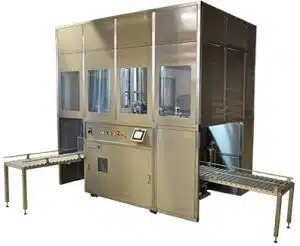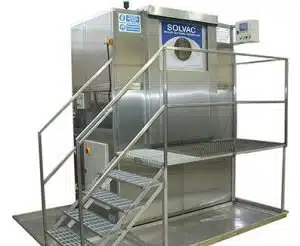CONTENT ON THIS PAGE IS RETAINED FOR INFORMATION ONLY
DUE TO n-Propyl bromide now being included in Annex 14 of REACH
EnviroTech Europe Ltd (ETE) continue to publish it as historical information and to record changes occurring in legislation which have affected decisions on formulations and equipment used in vapour degreasing - the most effective, quickest, flexible and cheapest cleaning system used in industry.
EnSolv® invented and patented by EnviroTech has been a market leader all over the world for vapour degreasing. It is based on n-bromopropane (nPB) which now cannot be used as a vapour degreaser within the UK or EU without authorisation.
Archived information about EnSolv® can be found using the Discontinued Products & Resources navigation menu on this page.
Using experience accumulated over 40 years supplying and supporting users of the vapour degreasing process ETE specialists have developed “drop in” alternatives:
ProSolv®, ProSolv5408e® and EnSolv CC-A® give the same or improved level of performance and economy as the original EnSolv® products.
Please contact our advisers who are available to discuss your needs and propose the best replacement product.
Or please click here to return to our vapour degreasing products homepage for information about our current products.

The future for solvent vapour degreasing equipment – Innovation driven by legislation.
Vapour degreasing is the simplest but most effective degreasing and cleaning process for industrial use. It has, until recently, been subject to little change since it was first invented in the early part of the last century. The name for the process is a misnomer as the cleaning is achieved by solvent vapour condensing on the cooler target parts the hot liquid solvent dissolving oil and removing dirt.
Vapour degreasing is a mature chemical technology on which legislation is now effecting changes so fundamental that the more accurate name for the process “Condensation Cleaning” should be used to reflect the way in which it works. The open topped tanks so ubiquitous in factories and workshops worldwide are no longer acceptable and the alternatives in equipment design and their fundamental differences in technology which guarantee the continuing use of vapour degreasing in the future need to be considered and understood.
In Europe the United States and in other advanced industrialised economies increasingly stringent legislation to control emissions of VOCs and especially solvents has led to new formulations for paints and other coatings where water replaces most of the solvent. In the early days the quality of the coatings was not as good as solvent based coatings but innovation has driven the development of new polymers with results as good as, if not better than, the solvent based originals.
As with coatings, cleaning systems have had to change. With increased regulation users of solvent have been targeted and alternatives are encouraged by the relevant authorities and law makers often without serious consideration of unintended consequences.
For example water based cleaning is the obvious alternative but this has many disadvantages compared to condensation cleaning as although the machines are simple and relatively cheap the processes require multiple tanks for immersion or spray processing or long programmed cycles in batch machines for cleaning, rinsing and drying. Water based processes are slow, energy intensive and occupy more floor space than condensation cleaning equivalent where only one tank with small footprint is needed delivering shorter process times and most importantly using minimal energy.
The ideal cleaning process would be “Condensation Cleaning” with water but due to the physical characteristics of the water vapour/steam and the inability to carry onto the surface of the targeted parts surfactants to remove the oil, grease and soils and the difficulty of rinsing and especially drying this can only ever be a dream.
A little history of the chemistry helps to explain the changes since the introduction of the vapour degreasing process. Suitable chemicals must be very good solvents for oil, grease, and other industrial soils non-flammable, safe for users and the environment and very stable when heated continuously for long periods.
Halogenated hydrocarbons are the solvents of choice for “Condensation Cleaning”. The process is essentially simple. A tank with a sump to contain the solvent, heaters at the base and condensation coils around the top section to control the height of the vapour is all that is required. When heated in the sump halogenated solvents produce, a saturated vapour between 3 and 4 times heavier than air at a temperature greater than the ambient conditions. This allows the solvent vapour to condense on the surface of the parts to be cleaned. The condensate dissolves the contaminants such as oil, greases and soils returning the used solvent into the sump of the machine for recycling into vapour which continuously condenses onto the parts until they have achieved the same temperature as the solvent vapour when, with no further condensation, the process is complete. Parts removed from the cleaning machines are very clean, warm and dry.
The most common halogenated solvents, in use for commercial purposes, are non-flammable so present no risk in this process. Perchloroethylene, used mainly for dry cleaning, methylene chloride used more widely in paint strippers and trichloroethylene used for vapour degreasing were the original materials used based on chlorine chemistry. However continuing concern about the environmental impact and danger to operators by exposure to chlorine based solvents, especially trichloroethylene, has led to a continuing search for safer alternatives.
1,1,1 trichloroethane (Genklene from ICI and Chlorothene from Dow Chemicals) both of which were based on another chlorinated solvent were to become ubiquitous in the mid part of the last century as a much safer, non- carcinogenic replacement for trichloroethylene. This was an excellent solvent safe for users but which, with increased awareness of the environmental impact of solvents, proved to be depleting the protective ozone layer around the Earth and was subsequently, banned. With the development of the REACH legislation in Europe, which now classifies trichloroethylene as a human carcinogen, usage is allowed but with restrictions and stringent controls for use authorised in machines which control factory emissions to very low figures close to zero.
Meanwhile cleaning solvents based on 1-bromopropane such as EnSolv were developed in the United States as a drop in replacement for trtichloroethane. EnSolv has an identical profile, stable, non-flammable, with the same physical characteristics such as boiling point and specific gravity and it is an excellent cleaning solvent but without the potential for ozone depletion.
During this time new halogenated solvent blends using trans1.2 dichloroethylene, a highly flammable solvent with similar chemistry to trichloroethylene were also developed for condensation cleaning. The trans 1.2 dichloroethylene is blended with a variety of different fluorocarbon solvents which are not suitable as cleaning solvents, as they have very low solvency, but are used in these blends as a fire retardants. An extremely expensive answer to a simple problem, already solved by the development of machines able to safely use the more economical solvents.
As with all legislation for the use of chemicals regulation and restrictions drive development of associated processes and equipment. The most important developments in machines to use solvents for condensation cleaning use two different approaches and raise difficult questions as to which is the best most economical and simplest in use.

Figure 1 – Solvac Automatic hermetically sealed vapour/liquid cleaning system conveyor fed.
The single tank hermetically sealed machines favoured by some equipment manufacturers uses a process tank to contain the solvent and a separate storage tank/vapour generator. Baskets, containing soiled parts, are loaded from the top or through access points on the side of the tank. Lids or doors close over the opening and the process tank is hermetically sealed. Baskets are immersed in solvent, where agitation, ultrasonics or pumped liquid is circulated through the parts.
When the immersion process is completde solvent is removed to the storage tank and vapour fed to the process tank from a vapour generator for rinsing and drying. On completion of the cycle coil,s located within the process tank collapse the vapour. The process tank is evacuated by vacuum and recycled through carbon absorption units to remove traces of solvent from the air until the concentration is below limits set by regulators when the lid opens automatically for the basket of parts, clean and dry, to be safely removed and replaced with a further basket.
Variations of process within the hermetically sealed tank are possible using sprays of cold or hot condensed solvent, immersion with or without ultrasonics and revolving baskets to deal with the problems experienced when processing machined and fabricated parts. Continuous external distillation of the contents of the vapour generator is also an option depending on contamination.
The alternative technology is much simpler and cheaper using well tried techniques not requiring the long recovery times of the hermetically sealed processes. The multilevel system uses a standard vapour degreasing tank design with a sealed loading section above the process tank.

Figure 2 Solvac 1000 – Hermetically sealed multilevel vapour degreasing system for manual load batch processing.
Components, to be cleaned, in baskets or on jigs, are fed to the automated hoist in the load section manually, by hoist or conveyor. The loading door is sealed pneumatically to completely isolate the process. The process tank sealing lid opens and the basket lowered into the process chamber. Depending on the soils simple condensation cleaning can be used or with the lower section being filled with clean solvent for immersion cleaning with or without ultrasonics or power sprays. Revolving baskets are a further option to improve cleaning in blind or through holes or oil ways in castings and fabrications.
With the process completed the basket rises to the freeboard area where the condensation coils are located and parts allowed to drain and dry. The tank seal opens to allow the basket into the load section while the lid closes to seal the process tank. A fan is then activated which produces a negative vacuum in the load area. The loading door partially opens to allow a flow of air through the loading section which is exhausted to atmosphere or can be recycled through carbon absorption systems.
As baskets entering the loading space contain parts drained and dried only very small amounts of solvent are carried in the exhausted air which is monitored to ensure compliance with appropriate legislation. When this is completed the door opens fully for removal of cleaned components. The loading section can be fitted with top or side sealed doors allowing baskets to flow through on conveyor systems or be loaded from hoists. No solvent enters the work area.
Both processes will produce parts cleaned to the highest standards but the choice of which offers the best solution needs a little more consideration.
The hermetically sealed vacuum process is complicated with the need to move liquids in the machine. It is relatively slow as the carbon adsorption process needs to remove high levels of solvent from the recirculated airstream from the process tank. This is inefficient as adsorption rates for carbon fall rapidly with increasing saturation. Final levels of solvent in the tank when the lid or loading door opens will be emmited into the workspace and the area in which the operator is working. Long process cycles reduce throughput.
The simpler multilevel systems where movement of liquids is not required are more efficient and offer much faster process times. Cost of manufacture is also lower as no liquid movement or vacuum is involved. The extracted loading section ensures no leakage of solvent into the work area which gives complete safety for operators and factory staff. The disadvantage of the multilevel machine is the height of the equipment compared to the hermetically sealed machine. This will often need the equipment be installed in a pit for easy access.
Both designs of process machines fully comply with the emission regulations of the EU and U.S authorities. Which to choose will depend on many factors which should be discussed with both the equipment and solvent suppliers who have the experience to advise on which offers the best process for the application. Equipment and solvent work together as a process and it is essential to ensure that the suppliers work closely together to offer a package with high levels of responsible care and product stewardship to ensure the best results and safest installation.
The “Condensation cleaning” process still gives the highest levels of economical cleaning with minimum energy usage, low footprint on the factory floor, safety for the operator, and high production rates with low solvent usage or environmental impact. With the new generation of sealed cleaning machines its future as the process of choice for industrial cleaning is assured.
EnSolv cleaning solvents are supplied throughout Europe.
We can provide you with a Material Safety Data Sheets, independent laboratory reports, product samples and technical assistance.
For more information or advice please telephone us on +44 (0) 20 8281 6370 or use our contact form.
All products are supplied and supported by EnviroTech Europe Ltd. Manufactured in the United Kingdom and available on short delivery times through our dedicated team of distributors worldwide.
Share this page:
Related Posts

